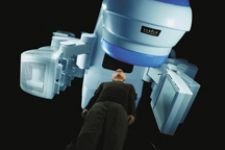
On Varian's linear accelerator Trilogy, imaging capabilities enable images to be immediately available and provide higher accuracy.
Until recently, certain types of cancer patients had very few or no options after they had been turned down as candidates for traditional surgery. Surgeons may reach the conclusion that surgery will not be effective for a patient if a tumor is in an unreachable anatomical location or the patient’s medical history includes special concerns.
SBRT changes the prognosis
Recently, Jeffrey D. Bradley, M.D., associate professor of radiation oncology, Washington University School of Medicine in St. Louis, treated a female patient in her sixties whose pulmonologist had discovered a small tumor growing in one of her lungs. The main complicating factor for her was that she had serious emphysema and was using oxygen on a regular basis. She wasn’t a candidate for traditional surgery because her lungs’ capacity for breathing was already so low that the consulting surgeon didn’t think she could survive it.
“This patient’s pulmonologist was unaware that image-guided stereotactic body radiotherapy (SBRT) existed, so when the surgeon referred the case to me for evaluation I was pleased to present the case to our hospital’s tumor board. The group agreed that SBRT was applicable, so we treated her 2-cm tumor. After a year, her cancer has been locally controlled, and her lung function is no worse than it was before treatment,” reported Dr. Bradley.
Targeting hard to reach tumors
What’s exciting about SBRT is that while initially the technology was used primarily for tumors in the brain, as targeting them with radiation requires great accuracy and precision, it has since been adapted for radiation therapy treatment for other areas of the body. A subspecialty of image-guided radiation therapy (IGRT), SBRT enables delivery of extremely precise high doses of radiation to a malignant or benign tumor that is small, may be hard to reach and is located typically in the head or neck, lung, liver or various abdominal sites. With tighter margins, less normal tissue is affected, so there are fewer side effects for patients. Plus, fewer treatment sessions are required to deliver the same total amount of radiation.
Other advantages to SBRT may depend on the system used. On Varian’s linear accelerator Trilogy, imaging capabilities enable images to be immediately available, designed to provide higher accuracy. As some tumors, such as lung, abdominal and prostate, move more due to their body location, the Trilogy has a gated tracking system that can measure tumor movement and then sync with the patient’s breathing to select the moments when the tumor is moving the least. Patient positioning is reportedly faster due a remote-controlled couch, and seamless workflow unites required functions in a single unit in one room.
SBRT vs. IMRT
In intensity-modulated radiation therapy (IMRT) doses of radiation are delivered from various angles to target a tumor. In SBRT high doses of radiation are delivered directly at the small tumor that has been imaged immediately before the treatment begins. “With this model, high quality images of the tumor may be taken just before treatment so the tumor hasn’t had a chance to move. In lung cancers, my specialty, this has been a problem,” stated Dr. Bradley.
SBRT also has a tighter margin than IMRT for dose delivery even when adjusting for respiratory motion. “We typically treat tumors of 2 to 3 cm. I have one year and eight months experience with the Varian Trilogy System. It allows us to have tighter margins so less normal tissue is affected by the radiation. This often means fewer side effects for patients because they have less to recover from.”
SBRT shapes future of radiotherapy
William F. Regine, M.D., professor and chair, Department of Radiation Oncology, University of Maryland Medical System, praises the new technology as well. “I have treated more than 100 patients with SBRT in the last few years and now I’m using the technology every day. In one case, I treated a male in his seventies who had early stage lung cancer. Before SBRT, he would have had to have an entire lung removed. We used the gating function of the Varian linear accelerator to track the tumor’s movement and target the tumor precisely. I also use SBRT to treat liver and other abdominal tumors.”
Precision in targeting the tumor to maximize dose delivery is the goal of radiation therapy, and using technology to enable SBRT brings clinicians another step closer to that objective. William Small, Jr., M.D., associate professor and vice chair, Department of Radiation Oncology, and associate medical director of the Robert H. Lurie Cancer Center at Northwestern University, commented, “Every few years a new treatment comes out that really changes things. Purchasing and installing a linear accelerator requires a lot of serious planning and physical facilities must be modified to suit its functioning.” Dr. Small explained that the hospital recently installed Varian’s linear accelerator for the new Prentice Women’s Hospital, enabling physicians to perform SBRT.
Drs. Bradley and Regine emphasized the importance of training for radiation physicians wanting to perform SBRT. Training from the equipment manufacturer, courses through the American Society for Therapeutic Radiology and Oncology (ASTRO) and other key professional organizations are important. Also key is observation at other medical centers already using SBRT. “Training in this field is continuous,” said Dr. Regine, “because high doses of radiation are given and SBRT is more complex, you need to get comfortable with what you’re doing.”
Because SBRT is still relatively new, Dr. Small said that large clinical trials still need to be done to research patient outcomes comparing lower radiation doses delivered over many treatments versus higher doses delivered over fewer treatments. Dr. Bradley estimated that SBRT has been used in the United States for about five years, although Japan and some European countries, such as Sweden, have been using it somewhat longer. Predictions are that due to the advantages SBRT is exhibiting, it will increasingly be used worldwide.


 December 11, 2025
December 11, 2025 









